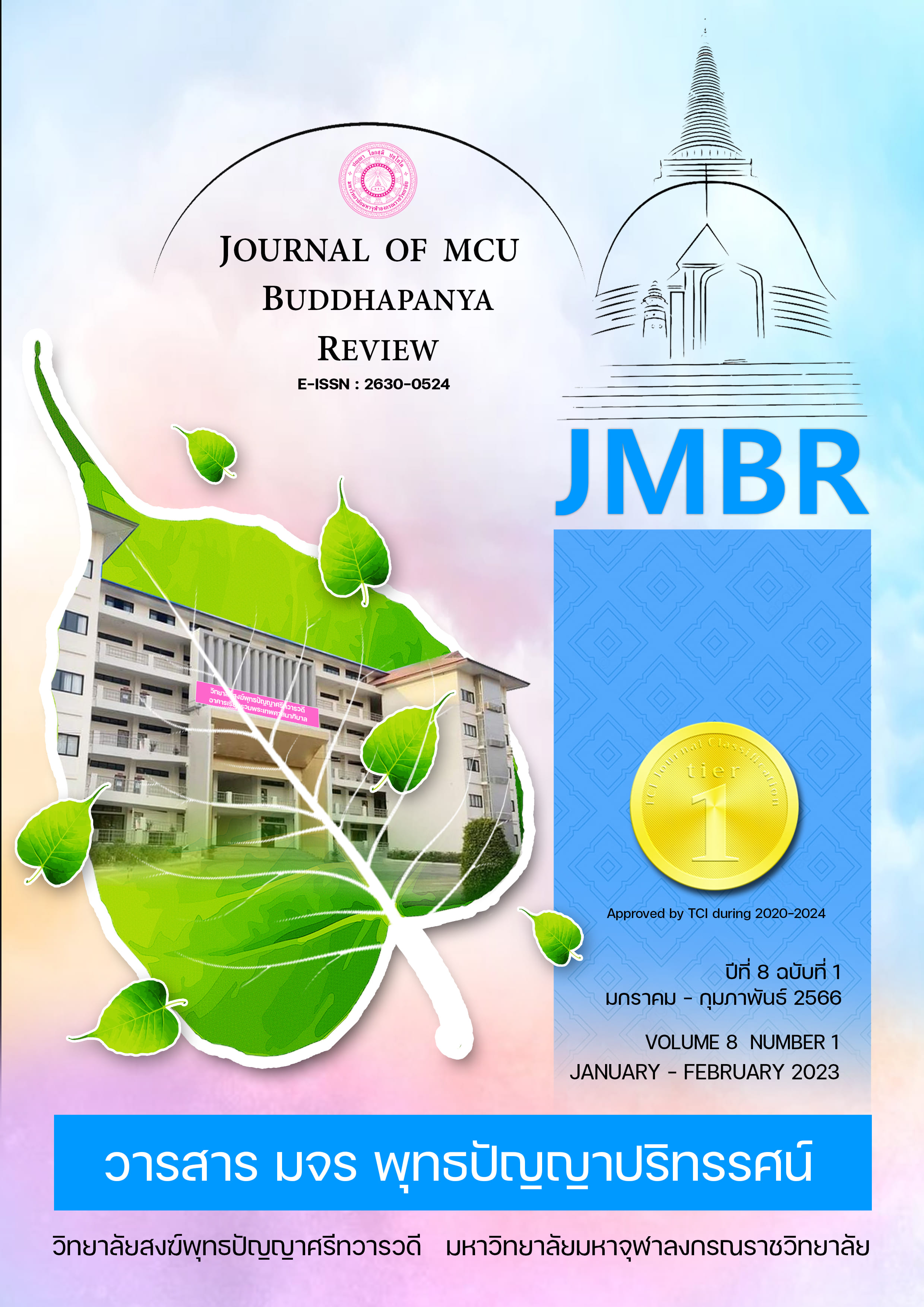การมีส่วนร่วมของนักเรียนในกลุ่มย่อยในชั้นเรียนที่เน้นการแก้ปัญหา
คำสำคัญ:
การมีส่วนร่วมของนักเรียน, กลุ่มย่อย, ชั้นเรียนที่เน้นการแก้ปัญหาบทคัดย่อ
การวิจัยครั้งนี้มีวัตถุประสงค์เพื่อวิเคราะห์ระดับการมีส่วนร่วมของนักเรียนในกลุ่มย่อยในชั้นเรียนที่เน้นการแก้ปัญหา กลุ่มเป้าหมายในการวิจัยครั้งนี้ คือ นักเรียนชั้นประถมศึกษาปีที่ 5 จำนวน 8 คน ภาคเรียนที่ 1 ปีการศึกษา 2564 โรงเรียนบ้านบึงเนียมบึงใคร่นุ่นท่าหิน จังหวัดขอนแก่น เครื่องมือที่ใช้ในการเก็บรวบรวมข้อมูล ได้แก่ 1) แผนการจัดการเรียนรู้ในหน่วยที่ 6 การหารทศนิยม จำนวน 5 แผน 2) แบบบันทึกภาคสนาม 3) ใบกิจกรรม 4) แอปพลิเคชัน Messenger 5) กล้องถ่ายภาพ นำเสนอการวิเคราะห์ด้วยการบรรยายเชิงวิเคราะห์ที่แสดงแนวคิดการมีส่วนร่วมของนักเรียนในกลุ่มย่อย ตามกรอบแนวคิดกลุ่มย่อยของ Kagan (1994) และตามกรอบแนวคิดการมีส่วนร่วมของ Webb et al. (2014)
ผลการวิจัยพบว่า ในชั้นเรียนที่เน้นการแก้ปัญหาเปิดโอกาสให้นักเรียนได้ทำงานกลุ่มย่อยและเข้าร่วมอภิปรายแลกเปลี่ยนแนวคิดกับเพื่อนเกี่ยวกับวิธีการแก้ปัญหาการหารทศนิยม ซึ่งเป็นการเรียนรู้คณิตศาสตร์ด้วยตนเอง นักเรียนส่วนใหญ่มีส่วนร่วมในกลุ่มย่อยระดับสูง นั่นคือ นักเรียนเกิดเป้าหมายร่วมกันเกี่ยวกับการหารทศนิยม เนื่องจากนักเรียนได้รับโอกาสในการลงมือแก้ปัญหาด้วยตนเอง เมื่อมีโอกาสคิดและแก้ปัญหาด้วยตนเองนักเรียนจึงกำหนดเป้าหมายในการแก้ปัญหาการหารทศนิยม ซึ่งเป้าหมายเกี่ยวกับการหารทศนิยมของนักเรียนที่กำหนดขึ้นสอดคล้องกับเป้าหมายของเพื่อน จึงก่อให้เกิดลักษณะของกลุ่มย่อย นอกจากนี้นักเรียนยังมีแนวคิดเป็นของตนเองแล้วนักเรียนนำเอาแนวคิดมาอภิปรายแลกเปลี่ยนกัน นักเรียนรับฟังแนวคิดของเพื่อน และนักเรียนเพิ่มเติมแนวคิดของเพื่อนหรือปรับเปลี่ยนแนวคิดให้มีความเหมาะสมขึ้นเกี่ยวกับการหารทศนิยมขณะที่มีการแก้ปัญหา จนสามารถบรรลุเป้าหมายร่วมกัน จึงทำให้การมีส่วนร่วมในการคิดแก้ปัญหาอยู่ในระดับสูง
เอกสารอ้างอิง
Abdullah MY, Bakar NR & Mahbob MH. (2012). The Dynamics of Student Participation in Classroom: Observation on Level and Forms of Participation. Procedia - Social and Behavioral Sciences, 59, 61–70.
Chiangkul, W. (2020). Will I Choose The Educational Revolution or Will I Choose Destruction?. Samut Sakhon: Plan Printing Co., Ltd. 11-35. [in Thai]
Cooper, M. (1999). The School to Find out How to Best Practices of Teachers. New York :McGraw-Hill.
Inprasithaha, M. (2011). One Feature of Adaptive Lesson Study in Thailand: Designing a Learning Unit. Journal of Science and Mathematics Education in Southeast Asia, 34(1), 47–66
______, (2014). Processes of Problem Solving in School Mathematics. Khonkaen: Penprinting. [in Thai]
______, (2018). Seminar About the Curriculum for Developing Teachers and Educational Staff [Recording]. Chiang Mai: Program in Mathematics Education, Faculty of Education, Khon Kaen University. [in Thai]
Isoda, M. (2010). Lesson Study: Problem Solving Approaches in Mathematics Education as a Japanese E×perience. Procedia Social and Behavioral Sciences, 8, 17–27.
Isoda, M. & Nakamura, T. (2010). The Theory of Problem-Solving Approach. Journal of Japan Society of Mathematical Education, 92(Special Issue), 11-12.
Kagan, S. (1994). Cooperative Learning. San Clemente, CA: Kagan Publishing.
Lewis, C. (2002). Does Lesson Study Have a Future in the United States. Nagoya Journal of education and Human Development, 1, 1-23.
National Council of Teachers of Mathematics [NCTM]. (1989). Curriculum and Evaluation Standards for School Mathematics. Virginia: NCTM, Inc.
Phanit, W. (2012). The Way to Build Leaining for Discoples in the 21st Century. Bangkok: Sodsri-Saritwong Foundation. [in Thai]
______, (2018). University Role: Public Enggagement in UK. Bangkok: Knowledge Network Institute of Thailand. [in Thai]
Rapke, T., Hall, J., & Marynowski, R. (2018). Re-framing testing to better fit within problem-solving classrooms: ways to create and review tests. In A. Kajander, J. Holm, & E. J. Chernoff (Eds.), Teaching and Learning Secondary School Mathematics: Canadian Perspectives in an International Context (1st ed., pp. 465-471). Cham Switzerland: Springer.
Samovar, L., Henman, L. & King, S. (1996). Small group Process. In R. S. Cathcart. L. A. Samova & L. D. Henman (Eds.). Small group in small group communication: Theory and practice. (pp.7-11). Dubuque: A Times Mirror.
Stigler, J. & Hiebert, J. (1999). The Teaching Gap: Best Ideas from The World’s Teachers for Improving Education in The Classroom. New York: The Free Press.
Webb, N. M., Franke, M. L., Ing, M., Wong, J., Hernandez, C. H., Shin, N., et al. (2014). Engaging with Others’ Mathematical Ideas: Interrelationships among Student Participation, Teachers’ Instructional Practices and Learning. International Journal of Educational Research, 63, 79–93.
ดาวน์โหลด
เผยแพร่แล้ว
รูปแบบการอ้างอิง
ฉบับ
ประเภทบทความ
สัญญาอนุญาต
ลิขสิทธิ์ (c) 2023 วารสาร มจร พุทธปัญญาปริทรรศน์

อนุญาตภายใต้เงื่อนไข Creative Commons Attribution-NonCommercial-NoDerivatives 4.0 International License.



